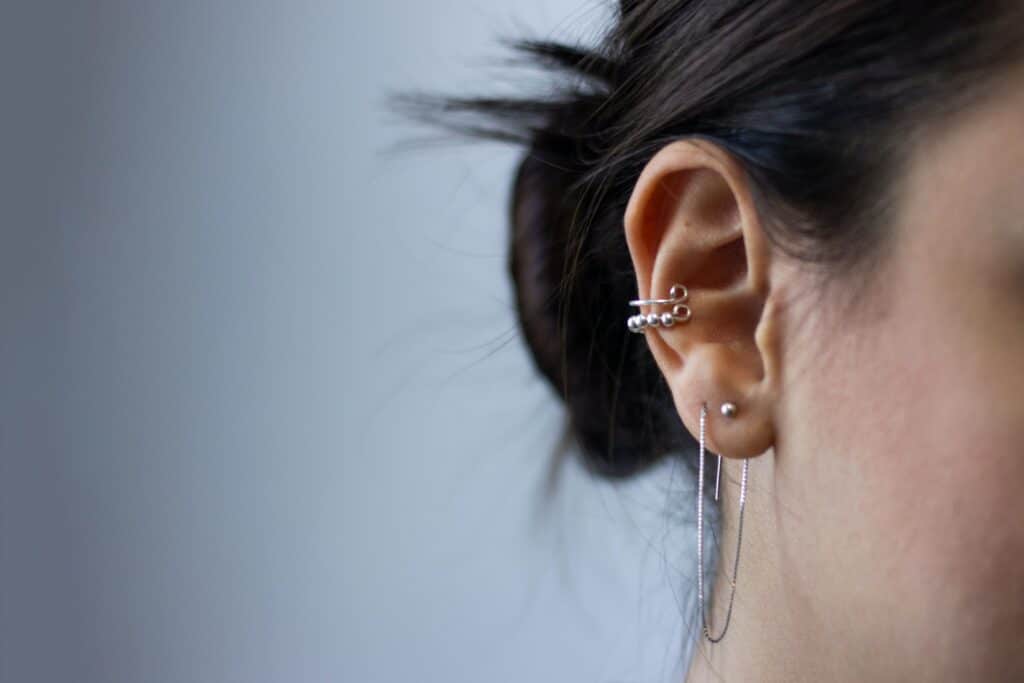Lyme disease (LD) is a multisystem condition caused by certain species of spirochetes from the Borrelia burgdorferi complex. The bacteria can spread to multiple organs throughout the body causing a wide range of symptoms. In this article we will discuss the faces of lyme disease and break down the common term of ‘lyme disease face’ into many parts.
The face of Lyme Disease can present itself in many forms, as the spirochete will often attack the fifth cranial nerve (V) and seventh cranial nerve (VII) presenting as TMJ, Bell’s Palsy, Dystonia, and Ramsey Hunt Syndrome. When Lyme disease attacks the fifth cranial nerve it affects the temporomandibular joint (TMJ) and can be misdiagnosed as a common temporomandibular disorder (TMD). The facial nerve, also known as the seventh cranial nerve, develops from the pons of the brainstem, controls the muscles of facial expression, and functions in the transmission of taste sensations from the anterior two-thirds of the tongue. While this article covers the faces of lyme disease we have a dedicated article to the symptoms of lyme disease.
Lyme Disease Jaw Pain
The most common non-dental orofacial pain conditions are temporomandibular disorders (TMDs).1 Temporomandibular disorder (TMD) signs can include: limitation of mouth opening, jaw pain, joint sounds such as clicking noises, undifferentiated neuralgic facial pain, disorder of mandibular mobility, ear pain, joint sound, and sometimes hypermobility of the joint.2 It is not uncommon for patients suffering from Lyme disease to be misdiagnosed for years with TMD and consequently undergo inappropriate treatment.
One study examined a 16-year-old male, who was evaluated for a 6-week history of left temporomandibular joint pain and dislocation, bilateral forearm pain, occasional right patella pain, and fatigue. It was also stated that two months prior to this clinical exam, he had been in Massachusetts and developed a rash on his right scalp and neck area. This was followed by development of left-sided Bell’s palsy, low grade fever, and left mandibular (lower jaw) pain. While the Bell’s palsy (lyme disease face), rash, and left mandibular pain resolved, the patient subsequently developed right lower jaw deviation, dislocation, and pain. MRI of TMJ’s revealed bilateral fluid collection, and TMJ arthritis secondary to Lyme disease was suspected and confirmed by a positive Lyme test. The patient was subsequently treated for Lyme disease. He also received bilateral TMJ diagnostic arthroscopy followed by arthrocentesis with joint lavage and injections of the TMJ’s.3

Lyme Disease Face – What Is It Really?
Another study looked at a 38-year-old male patient who upon his neurologic exam showed decreased sensation to fine touch and temperature on the left side of his face in the entire distribution of the fifth cranial nerve. “The patient had incomplete left sided facial weakness with forehead sparing with inability to close his left eye independently. He had mild rightward gaze palsy with left eye delay and incompleteness in tracking in all directions and decreased left sided palatal elevation with rightward uvula deviation”4. The patient was later diagnosed with Lyme disease, through a positive Western blot, with 7 positive bands for IgG and 3 positive one for IgM. He completed his antibiotic course and had resolution of all his neurologic deficits as well as his headache.4 When Lyme disease it caught early; antibiotics can be very helpful in the treatment process. However, during late-stage Lyme disease, biofilms form. Antibiotics are oftentimes unable to penetrate the biofilms around the spirochete to attack the infection. This is where integrative medicine is likely necessary to implement in the treatment process. Lyme Disease should be considered in the differential diagnosis of patients presenting with TMJ, Bell’s palsy, rash, and fatigue.
Bell’s Palsy Lyme Disease
Bell’s palsy is one of the most common manifestation of Lyme neuroborreliosis (or neurological Lyme disease) in the US.5 This condition is characterized by the sudden onset of facial paralysis that is commonly followed by a slight fever, pressure behind the ear on the affected side, and neck and face stiffness. Paralysis is caused from decreased blood supply and/or compression of the seventh cranial nerve. This compression can be the result of inflammation of the tissue around the nerve. This is what most pople mean when they say Lyme Diease Face.
It is important for frontline physicians to be aware that when a patient comes in with Bell’s palsy, they should consider:
- The prevalence of ticks and Lyme disease in the geographic area in which the patient lives or if they have traveled to a Lyme epidemic area.
- Health history of the individual that may increase the risk of coming into contact with ticks (time of year, outdoor activities, pets).
- Other symptoms consistent with tick-borne infections (EM, flu like symptoms, arthritis, carditis, other neurological complications, etc.).5

Lyme Disease Dystonia
Similarly, to Bell’s palsy, dystonia is another disorder that is often caused by Lyme disease and affects the seventh cranial nerve. Dystonia is a complex neurological movement disorder characterized by involuntary muscle contractions. I have had my own personal experience with Lyme disease damaging my seventh cranial nerve. I developed cervical dystonia after being bitten by a tick. I was 18 years old, and at that time was battling undiagnosed Lyme encephalitis that progressed into a movement disorder. I no longer had control over my neck, and I have had to receive botulinum injections every three months for the past 17 years to help my neck function properly. While the type of dystonia I have has impacted my cervical region, dystonia can also impact your jaw, tongue, eyes, and face causing involuntary muscle contraction in those areas.6
I have been treated by the same Movement Disorder Physician since I was 18 years old. Every year I ask him if he is seeing a correlation between tick-borne infections and movement disorders. Every year he gives me the same answer, “that Lyme disease can not cause movement disorders”. For over a decade, I have been working with people battling Lyme disease, and about 15% of them have also developed a type of movement disorder. A number of these people are being treated for cervical dystonia and go to the very same Movement Disorder Physician that I see at one of the top facilities in NYC. It is unfortunate, because I was diagnosed with cervical dystonia three months after being bitten by a tick. I was told that it was caused by an unknown virus that was no longer in my system. It took another 4 ½ years with multiple tick-borne infections actively attacking my body before receiving the correct diagnosis. It is a huge disservice to the Lyme community for mainstream medicine to not recognize the correlation between tick-borne diseases and movement disorders.
Lyme Disease Ramsey Hunt Syndrome
Ramsey Hunt Syndrome attacks the seventh cranial nerve as well. We are seeing a rise in people with chornic Lyme disease later developing Ramsey Hunt Syndrome, as people who are immunocompromised are more likely to be affected with this condition. Ramsay Hunt syndrome occurs when the varicella-zoster virus reactivates and spreads to the facial nerves near your inner ear. This may appear in some cases to be what people have called ‘lyme disease face’. The varicella-zoster virus is the same virus that is brought on by chickenpox and shingles (herpes zoster), resulting in inflammation of the geniculate ganglion of cranial nerve VII. Ramsay Hunt is a clinical diagnosis and often is described as a triad of ipsilateral facial paralysis, otalgia, and vesicles near the ear and auditory canal.

Justin Beiber Lyme Disease
The Grammy-winning singer, Justin Bieber who has been battling Lyme disease for over four years, has been recently diagnosed with Ramsey Hunt Syndrome. Justin Bieber has created awareness on the severity of tick-borne infections by being candid with the public on his journey. He filmed a documentary on his YouTube channel, called The Dark Season where he shares the symptoms of fatigue, anxiety, depression, brain fog and the details of his diagnosis and treatment for Lyme disease.7
This past June, Bieber reveals that he will unfortunately be canceling his tour, as his symptoms have continued to progress. He states that “I have this syndrome called Ramsay Hunt syndrome, and it is from this virus that attacks the nerve in my ear and my facial nerves and has caused my face to have paralysis.”8 Bieber demonstrates in the video how he can’t make his eye blink or his nostril flare on the right side of his face. Even for people with all the resources, treatment of pathogenic infections can be very complex, as Lyme suppresses your immune system and allows you body to become more susceptible to other viruses. As the pathogenic load increases, treatment becomes more complicated.
There have been numerous publications on Lyme disease effecting the fifth and seventh cranial nerves causing damage and an array of severe disorders. However, there are still so many people battling these conditions without recognizing that the cause of their condition is due to Lyme disease. The more we can do to create awareness on these correlations can hopefully intern help individuals treat the actual cause of their condition and have a better chance of recovery.
Citations:
- Durham J., Al-Baghdadi M., Baad-Hansen L., Breckons M., Goulet J.P., Lobbezoo F., List T., Michelotti A., Nixdorf D.R., Peck C.C., et al. Self-management programmes in temporomandibular disorders: Results from an international Delphi process. J. Oral Rehabil. 2016;43:929–936. doi: 10.1111/joor.12448. [PubMed] [CrossRef] [Google Scholar]
- Weise, C., Schulz, M.C., Frank, K. et al. Acute arthritis of the right temporomandibular joint due to Lyme disease: a case report and literature review. BMC Oral Health 21, 400 (2021). https://doi.org/10.1186/s12903-021-01744-4
- Jesse J. Xie; Nina T. Washington, MD, MPH; Ravi Chandran, DMD, PhD Pediatrics (2018) 141 (1_MeetingAbstract): 693. https://doi.org/10.1542/peds.141.1MA7.693
- Chaturvedi A, Baker K, Jeanmonod D, Jeanmonod R. Lyme Disease Presenting with Multiple Cranial Nerve Deficits: Report of a Case. Case Rep Emerg Med. 2016;2016:7218906. doi: 10.1155/2016/7218906. Epub 2016 Aug 21. PMID: 27635267; PMCID: PMC5011200.
- https://www.globallymealliance.org/blog/lyme-disease-and-bells-palsy-new-considerations-for-differential-diagnosis
- https://www.hopkinsmedicine.org/wilmer/services/oculofacial/reconstructive/eyelid_facial_squeezing.html
- https://www.lymedisease.org/members/lyme-times/2020-spring-news/justin-bieber-lyme-disease/
- https://www.nytimes.com/2022/06/10/well/live/ramsay-hunt-syndrome-facial-paralysis.html



